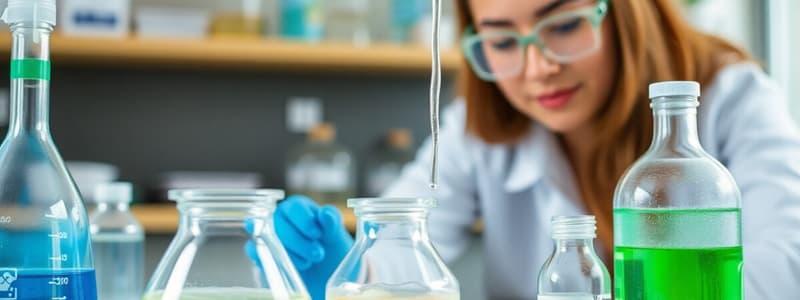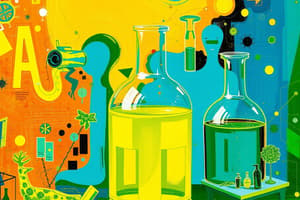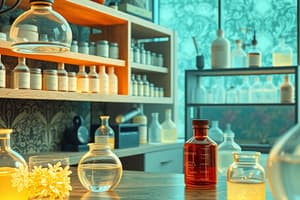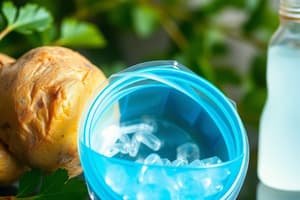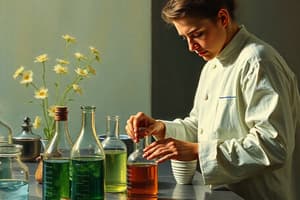Podcast
Questions and Answers
What is the primary source of conventional plastics?
What is the primary source of conventional plastics?
- Vegetable oil
- Renewable biomass sources
- Crude oil (correct)
- Natural starch
What is a primary benefit of bioplastics over traditional plastics?
What is a primary benefit of bioplastics over traditional plastics?
- They do not release carbon dioxide when burned.
- They are derived from renewable biomass. (correct)
- They decompose faster than traditional plastics.
- They are cheaper to produce than petroleum-based plastics.
Which type of bioplastic is commonly used for drug capsules and goods packaging?
Which type of bioplastic is commonly used for drug capsules and goods packaging?
- Synthetic bioplastic
- Cellulose based
- Protein based
- Starch based (correct)
Among the following, which bioplastic type is made from cellulose esters?
Among the following, which bioplastic type is made from cellulose esters?
What is one environmental concern associated with traditional plastics?
What is one environmental concern associated with traditional plastics?
What role does glycerol play when added to potato starch based bioplastics?
What role does glycerol play when added to potato starch based bioplastics?
Which type of plastic is broken down through exposure to sunlight?
Which type of plastic is broken down through exposure to sunlight?
What is the primary function of hydrochloric acid (HCl) in the formation of potato starch-based bioplastics?
What is the primary function of hydrochloric acid (HCl) in the formation of potato starch-based bioplastics?
Which of the following statements about biodegradation of bioplastics is true?
Which of the following statements about biodegradation of bioplastics is true?
What characteristic of glycerol contributes to the plasticization of potato starch bioplastics?
What characteristic of glycerol contributes to the plasticization of potato starch bioplastics?
What is a key advantage of bioplastics over conventional plastics?
What is a key advantage of bioplastics over conventional plastics?
Which type of bioplastic is primarily utilized for making body panels of automobiles?
Which type of bioplastic is primarily utilized for making body panels of automobiles?
What is a common source used to produce starch-based bioplastics?
What is a common source used to produce starch-based bioplastics?
What is the primary material used to manufacture cellulose-based bioplastics?
What is the primary material used to manufacture cellulose-based bioplastics?
Which factor is NOT associated with traditional plastics?
Which factor is NOT associated with traditional plastics?
What process describes the breakdown of organic materials by natural processes and micro-organisms?
What process describes the breakdown of organic materials by natural processes and micro-organisms?
What is the primary advantage of adding glycerol to potato starch-based bioplastics?
What is the primary advantage of adding glycerol to potato starch-based bioplastics?
Which of the following bacteria is NOT involved in the biodegradation of bioplastics?
Which of the following bacteria is NOT involved in the biodegradation of bioplastics?
What is the main purpose of using hydrochloric acid (HCl) in the formation of potato starch-based bioplastics?
What is the main purpose of using hydrochloric acid (HCl) in the formation of potato starch-based bioplastics?
Which of the following statements correctly describes a characteristic of potato starch?
Which of the following statements correctly describes a characteristic of potato starch?
What is a key environmental disadvantage of traditional plastics?
What is a key environmental disadvantage of traditional plastics?
What is the primary ingredient used to create starch-based bioplastics?
What is the primary ingredient used to create starch-based bioplastics?
Which type of bioplastic is commonly used in applications such as thermoplastics and packaging?
Which type of bioplastic is commonly used in applications such as thermoplastics and packaging?
Which of the following statements about bioplastics is true?
Which of the following statements about bioplastics is true?
What is one commonly known application for protein-based bioplastics?
What is one commonly known application for protein-based bioplastics?
What effect does the addition of glycerol have on potato starch-based bioplastics?
What effect does the addition of glycerol have on potato starch-based bioplastics?
What type of plastics degrade under exposure to water?
What type of plastics degrade under exposure to water?
Which of the following plays a role in enhancing the degradation of bioplastics?
Which of the following plays a role in enhancing the degradation of bioplastics?
What primary purpose does hydrochloric acid (HCl) serve in the production of potato starch-based bioplastics?
What primary purpose does hydrochloric acid (HCl) serve in the production of potato starch-based bioplastics?
Which of the following bacteria is involved in the biodegradation of bioplastics?
Which of the following bacteria is involved in the biodegradation of bioplastics?
What is a common source of renewable biomass used in the production of bioplastics?
What is a common source of renewable biomass used in the production of bioplastics?
Which type of bioplastic is primarily used for automotive body panels?
Which type of bioplastic is primarily used for automotive body panels?
What environmental problem is associated with traditional plastics when they are burned?
What environmental problem is associated with traditional plastics when they are burned?
What type of bioplastic is widely used in products like good packaging and drug capsules?
What type of bioplastic is widely used in products like good packaging and drug capsules?
Which bioplastic type is made from cellulose esters and is commonly used for thermoplastics?
Which bioplastic type is made from cellulose esters and is commonly used for thermoplastics?
What is the role of water in the biodegradation process of bioplastics?
What is the role of water in the biodegradation process of bioplastics?
How does the addition of glycerol affect the rigidity of amylose in bioplastics?
How does the addition of glycerol affect the rigidity of amylose in bioplastics?
Which of the following is true about the types of plastics mentioned?
Which of the following is true about the types of plastics mentioned?
What is the main function of amylopectin in potato starch?
What is the main function of amylopectin in potato starch?
Which factor significantly enhances the degradation of bioplastics?
Which factor significantly enhances the degradation of bioplastics?
Flashcards
Bioplastics
Bioplastics
Plastics derived from renewable biomass sources like vegetable oil or corn starch.
Starch-based bioplastics
Starch-based bioplastics
Bioplastics made from natural starch, commonly used in packaging and drug capsules.
Cellulose-based bioplastics
Cellulose-based bioplastics
Bioplastics made from cellulose esters, used as thermoplastics and for packaging.
Protein-based bioplastics
Protein-based bioplastics
Signup and view all the flashcards
Traditional Plastics
Traditional Plastics
Signup and view all the flashcards
Environmental Impact (Plastics)
Environmental Impact (Plastics)
Signup and view all the flashcards
Learning Objective (Bioplastics Experiment)
Learning Objective (Bioplastics Experiment)
Signup and view all the flashcards
Biodegradation
Biodegradation
Signup and view all the flashcards
Biodegradable plastics
Biodegradable plastics
Signup and view all the flashcards
Photodegradable plastics
Photodegradable plastics
Signup and view all the flashcards
Potato Starch
Potato Starch
Signup and view all the flashcards
Amylose
Amylose
Signup and view all the flashcards
Amylopectin
Amylopectin
Signup and view all the flashcards
Hydrochloric acid (HCl) purpose
Hydrochloric acid (HCl) purpose
Signup and view all the flashcards
Glycerol, purpose
Glycerol, purpose
Signup and view all the flashcards
Pseudomonas species
Pseudomonas species
Signup and view all the flashcards
Streptococcus species
Streptococcus species
Signup and view all the flashcards
Staphylococcus species
Staphylococcus species
Signup and view all the flashcards
Bioplastics degradation
Bioplastics degradation
Signup and view all the flashcards
Bioplastics
Bioplastics
Signup and view all the flashcards
Traditional Plastics
Traditional Plastics
Signup and view all the flashcards
Environmental Impact (Plastics)
Environmental Impact (Plastics)
Signup and view all the flashcards
Starch-based Bioplastics
Starch-based Bioplastics
Signup and view all the flashcards
Cellulose-based Bioplastics
Cellulose-based Bioplastics
Signup and view all the flashcards
Protein-based Bioplastics
Protein-based Bioplastics
Signup and view all the flashcards
Biodegradable Plastics
Biodegradable Plastics
Signup and view all the flashcards
Learning Objective (Bioplastics)
Learning Objective (Bioplastics)
Signup and view all the flashcards
Biodegradation
Biodegradation
Signup and view all the flashcards
Biodegradable plastics
Biodegradable plastics
Signup and view all the flashcards
Photodegradable plastics
Photodegradable plastics
Signup and view all the flashcards
Potato starch
Potato starch
Signup and view all the flashcards
Amylose
Amylose
Signup and view all the flashcards
Amylopectin
Amylopectin
Signup and view all the flashcards
HCl purpose
HCl purpose
Signup and view all the flashcards
Glycerol's purpose
Glycerol's purpose
Signup and view all the flashcards
Bioplastic degradation bacteria
Bioplastic degradation bacteria
Signup and view all the flashcards
Bioplastics
Bioplastics
Signup and view all the flashcards
Traditional Plastics
Traditional Plastics
Signup and view all the flashcards
Environmental Impact (Plastics)
Environmental Impact (Plastics)
Signup and view all the flashcards
Starch-based Bioplastics
Starch-based Bioplastics
Signup and view all the flashcards
Cellulose-based Bioplastics
Cellulose-based Bioplastics
Signup and view all the flashcards
Protein-based Bioplastics
Protein-based Bioplastics
Signup and view all the flashcards
Biodegradable Plastics
Biodegradable Plastics
Signup and view all the flashcards
Learning Objective (Bioplastics)
Learning Objective (Bioplastics)
Signup and view all the flashcards
Biodegradation
Biodegradation
Signup and view all the flashcards
Biodegradation
Biodegradation
Signup and view all the flashcards
Biodegradable plastics
Biodegradable plastics
Signup and view all the flashcards
Photodegradable plastics
Photodegradable plastics
Signup and view all the flashcards
Potato starch
Potato starch
Signup and view all the flashcards
Amylose
Amylose
Signup and view all the flashcards
Amylopectin
Amylopectin
Signup and view all the flashcards
HCl purpose (starch-bioplastic)
HCl purpose (starch-bioplastic)
Signup and view all the flashcards
Glycerol purpose (starch - bioplastic)
Glycerol purpose (starch - bioplastic)
Signup and view all the flashcards
Bacteria in biodegradation (Example)
Bacteria in biodegradation (Example)
Signup and view all the flashcards
Bioplastics Definition
Bioplastics Definition
Signup and view all the flashcards
Traditional Plastics
Traditional Plastics
Signup and view all the flashcards
Environmental Impact (Plastics)
Environmental Impact (Plastics)
Signup and view all the flashcards
Starch-Based Bioplastics
Starch-Based Bioplastics
Signup and view all the flashcards
Cellulose-Based Bioplastics
Cellulose-Based Bioplastics
Signup and view all the flashcards
Protein-Based Bioplastics
Protein-Based Bioplastics
Signup and view all the flashcards
Biodegradable Plastics
Biodegradable Plastics
Signup and view all the flashcards
Learning Objective (Bioplastics)
Learning Objective (Bioplastics)
Signup and view all the flashcards
Biodegradation
Biodegradation
Signup and view all the flashcards
Potato Starch
Potato Starch
Signup and view all the flashcards
Amylose
Amylose
Signup and view all the flashcards
Amylopectin
Amylopectin
Signup and view all the flashcards
HCl Purpose (Bioplastics)
HCl Purpose (Bioplastics)
Signup and view all the flashcards
Glycerol Purpose (Bioplastics)
Glycerol Purpose (Bioplastics)
Signup and view all the flashcards
Bacteria in biodegradation Example
Bacteria in biodegradation Example
Signup and view all the flashcards
Biodegradation
Biodegradation
Signup and view all the flashcards
Biodegradable plastics
Biodegradable plastics
Signup and view all the flashcards
Photodegradable plastics
Photodegradable plastics
Signup and view all the flashcards
Potato Starch
Potato Starch
Signup and view all the flashcards
Amylose
Amylose
Signup and view all the flashcards
Amylopectin
Amylopectin
Signup and view all the flashcards
HCl purpose (starch-based bioplastic)
HCl purpose (starch-based bioplastic)
Signup and view all the flashcards
Glycerol's purpose (starch-based bioplastic)
Glycerol's purpose (starch-based bioplastic)
Signup and view all the flashcards
Bacteria in biodegradation (example)
Bacteria in biodegradation (example)
Signup and view all the flashcards
Study Notes
Prayer Before Class
- Holy Spirit, the true source of light and wisdom, is asked to enlighten the intellect.
- Dispelling darkness (sin and ignorance) is requested.
- A penetrating mind, retentive memory, and the ability to comprehend and express are sought.
- Guidance and success in the work is requested.
- The prayer is made through Jesus Christ, the God and man, who reigns with the Father forever.
Post-Laboratory Discussion: Preparation of Biodegradable Plastics
- The discussion concerns the preparation of biodegradable plastics.
- This is for the Chemistry for Engineers Laboratory at UST General Santos.
Learning Objective
- Students aim to create a plastic film from potato starch by the end of the experiment.
Plastics
- Plastics are derived from crude oil (petroleum).
- They heavily depend on dwindling fossil fuel resources.
- Burning releases carbon dioxide, leading to global warming.
- Decomposition takes a long time.
Decomposition Times
- Presented are decomposition times for various materials.
- Batteries: 110 years
- Vegetable leaves/branches: Months
- Food waste: Months
- Newspapers: >1 month
- Office papers: 2 years
- Wax paper: 5 years
- Stub filter: 2-3 years
- Chewing gum: 30 years
- Natural fabric clothes: 2-3 years
- Synthetic fabric clothes: up to 40 years
- Shoes: natural materials-10 years, synthetic - 80 years
- Iron cans: 10 years, tin cans: 90, aluminum cans: 500
- Rubber tires: 120-140 years
- Glass: 1000 years
- Polyethylene bags, plastic bottles: 100-200 years
- Baby diapers: 200-500 years
What are Bioplastics?
- Bioplastics are plastics derived from renewable biomass sources.
- Typical sources include vegetable oil or corn starch.
Types of Bioplastics
- Starch based: Made from natural starch; used in packaging and drug capsules.
- Cellulose based: Made from cellulose esters; used in thermoplastics and packaging.
- Protein based: Made from proteins (soy, wheat); used in automobile body panels.
- Some aliphatic polyesters: Other types of bioplastics.
Characteristics of Petroleum-based vs. Bioplastics
| Feature | Petroleum-based Plastics | Bioplastics |
|---|---|---|
| Energy Consumption | High | 48% lower |
| Raw Materials | Petroleum (non-renewable) | Biomass (renewable) |
| Carbon Footprint | High | 62% less CO2 emission |
| Presence of Chemicals | Bisphenol A (BPA) present. | No toxic chemicals present |
| Physical Properties | Highly stable, thermo-plastic | Equally stable, high thermo-plasticity |
| Biodegradability | >1000 years to decompose | 180 days to decompose |
Biodegradability
- Biodegradation is a process where natural processes and microorganisms break down organic materials.
- Sunlight, water, bacteria, enzymes, and wind abrasion are involved.
Biodegradation of Bioplastics
- Biodegradation can occur via several soil bacteria, including Pseudomonas and Streptococcus species.
- Staphylococcus species also participate.
- Potato starch bioplastics degrade via polymer chain breaking by bacteria.
- Water absorption enhances bioplastic degradation.
Degradable Plastics Types
- Biodegradable Plastics: Contain a small percentage of non-oil-based material (like corn starch).
- Photodegradable plastics: Break down when exposed to sunlight.
Potato Starch
- Potato starch is a polymer made up of glucose units.
- It contains two carbohydrate polymers: amylose (long chain) and amylopectin (highly branched).
- Amylopectin makes up the majority of starch.
Potato Starch Based Bioplastic
- Hydrochloric acid (HCl) breaks down amylopectin to allow film formation.
Potato Starch Based Bioplastic - Glycerol
- Glycerol serves as a plasticizer, adding flexibility and elasticity to the bioplastic.
- It disrupts hydrogen bonds in starch molecules, weakening their rigid structure, making it more flexible.
- Glycerol absorbs moisture, further plasticizing the bioplastic.
End of Discussion
- The session concludes with a question-and-answer period.
Prayer After Class
- A prayer is offered to God for a mind to know Him, a heart to seek Him, wisdom to find Him, and the conduct pleasing to Him.
- Faithful perseverance and a hope to finally embrace Him are requested.
Studying That Suits You
Use AI to generate personalized quizzes and flashcards to suit your learning preferences.
